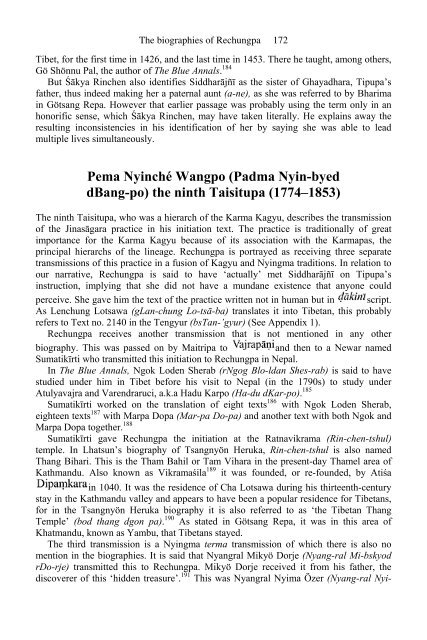The Biographies of Rechungpa: The Evolution of a Tibetan ...
The Biographies of Rechungpa: The Evolution of a Tibetan ...
The Biographies of Rechungpa: The Evolution of a Tibetan ...
You also want an ePaper? Increase the reach of your titles
YUMPU automatically turns print PDFs into web optimized ePapers that Google loves.
<strong>The</strong> biographies <strong>of</strong> <strong>Rechungpa</strong> 172<br />
Tibet, for the first time in 1426, and the last time in 1453. <strong>The</strong>re he taught, among others,<br />
Gö Shönnu Pal, the author <strong>of</strong> <strong>The</strong> Blue Annals. 184<br />
But Śākya Rinchen also identifies Siddharājñī as the sister <strong>of</strong> Ghayadhara, Tipupa’s<br />
father, thus indeed making her a paternal aunt (a-ne), as she was referred to by Bharima<br />
in Götsang Repa. However that earlier passage was probably using the term only in an<br />
honorific sense, which Śākya Rinchen, may have taken literally. He explains away the<br />
resulting inconsistencies in his identification <strong>of</strong> her by saying she was able to lead<br />
multiple lives simultaneously.<br />
Pema Nyinché Wangpo (Padma Nyin-byed<br />
dBang-po) the ninth Taisitupa (1774–1853)<br />
<strong>The</strong> ninth Taisitupa, who was a hierarch <strong>of</strong> the Karma Kagyu, describes the transmission<br />
<strong>of</strong> the Jinasāgara practice in his initiation text. <strong>The</strong> practice is traditionally <strong>of</strong> great<br />
importance for the Karma Kagyu because <strong>of</strong> its association with the Karmapas, the<br />
principal hierarchs <strong>of</strong> the lineage. <strong>Rechungpa</strong> is portrayed as receiving three separate<br />
transmissions <strong>of</strong> this practice in a fusion <strong>of</strong> Kagyu and Nyingma traditions. In relation to<br />
our narrative, <strong>Rechungpa</strong> is said to have ‘actually’ met Siddharājñī on Tipupa’s<br />
instruction, implying that she did not have a mundane existence that anyone could<br />
perceive. She gave him the text <strong>of</strong> the practice written not in human but in script.<br />
As Lenchung Lotsawa (gLan-chung Lo-tsā-ba) translates it into <strong>Tibetan</strong>, this probably<br />
refers to Text no. 2140 in the Tengyur (bsTan-’gyur) (See Appendix 1).<br />
<strong>Rechungpa</strong> receives another transmission that is not mentioned in any other<br />
biography. This was passed on by Maitripa to and then to a Newar named<br />
Sumatikīrti who transmitted this initiation to <strong>Rechungpa</strong> in Nepal.<br />
In <strong>The</strong> Blue Annals, Ngok Loden Sherab (rNgog Blo-ldan Shes-rab) is said to have<br />
studied under him in Tibet before his visit to Nepal (in the 1790s) to study under<br />
Atulyavajra and Varendraruci, a.k.a Hadu Karpo (Ha-du dKar-po). 185<br />
Sumatikīrti worked on the translation <strong>of</strong> eight texts 186 with Ngok Loden Sherab,<br />
eighteen texts 187 with Marpa Dopa (Mar-pa Do-pa) and another text with both Ngok and<br />
Marpa Dopa together. 188<br />
Sumatikīrti gave <strong>Rechungpa</strong> the initiation at the Ratnavikrama (Rin-chen-tshul)<br />
temple. In Lhatsun’s biography <strong>of</strong> Tsangnyön Heruka, Rin-chen-tshul is also named<br />
Thang Bihari. This is the Tham Bahil or Tam Vihara in the present-day Thamel area <strong>of</strong><br />
Kathmandu. Also known as Vikramaśila 189 it was founded, or re-founded, by Atiśa<br />
in 1040. It was the residence <strong>of</strong> Cha Lotsawa during his thirteenth-century<br />
stay in the Kathmandu valley and appears to have been a popular residence for <strong>Tibetan</strong>s,<br />
for in the Tsangnyön Heruka biography it is also referred to as ‘the <strong>Tibetan</strong> Thang<br />
Temple’ (bod thang dgon pa). 190 As stated in Götsang Repa, it was in this area <strong>of</strong><br />
Khatmandu, known as Yambu, that <strong>Tibetan</strong>s stayed.<br />
<strong>The</strong> third transmission is a Nyingma terma transmission <strong>of</strong> which there is also no<br />
mention in the biographies. It is said that Nyangral Mikyö Dorje (Nyang-ral Mi-bskyod<br />
rDo-rje) transmitted this to <strong>Rechungpa</strong>. Mikyö Dorje received it from his father, the<br />
discoverer <strong>of</strong> this ‘hidden treasure’. 191 This was Nyangral Nyima Özer (Nyang-ral Nyi-











